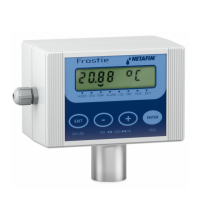HOw TO INSTALL ANd uSE FROSTIE
OvERvIEw
Frost damage occurs at low temperature, when leaf cells freeze and rupture. Humidity is also a major factor because the rate of
evaporation of moisture from the plants increases as humidity decreases; this evaporation chills the plant below the air temperature
and so the plant suffers frost damage at a higher temperature. FROSTIE compensates for this chill factor.
Heaters or sprinklers may be installed to protect against frost damage. Frost sprinklers protect plants by covering the leaves in sheets
of ice. Once frost sprinklers have been turned on, they should be kept on until the sun has melted all the ice from the plants. If not,
the temperature of the ice and the leaves can quickly drop below the plant cell freezing point, perhaps causing more frost damage
than if no protective sprinkling had been applied.
In automatic alarm mode, the alarm has two configurable timers that set the minimum amount of time for which the alarm output
will stay on and off.
The output will only change after a timer stops running and then only when alarm conditions change - it does not use the timers to
turn on, off, on, etc while the alarm condition prevails. The on timer ensures the plants receive at least a specified amount of heat/
sprinkling. The off timer ensures the plants and the heaters/sprinklers get a minimum rest between activation.
When operating heaters, the alarm On and Off times should be set to some small period, but large enough to prevent the heaters
from being turned on and off too frequently. When operating frost sprinklers, the alarm On time should be set to a long period,
perhaps 12 hours, to prevent interruption to water flow and to ensure the sprinklers do not turn off automatically before the crop has
been inspected. (Once frost sprinklers have been turned on, they should be kept on until the sun has melted all the ice from the
plants.) After the ice has melted, the sprinklers can be turned off manually - set the alarm mode to Off, then set it back to Auto ready
for the next frost event.
The alarm has configurable temperature hysteresis. This puts a gap between the alarm off temperature and the alarm on temperature,
so that the alarm output stays on long enough to have a measurable effect, rather than rapidly turning on and off. The alarm timers are
usually more effective for this purpose, so set hysteresis to zero unless you specifically need hysteresis.
17

